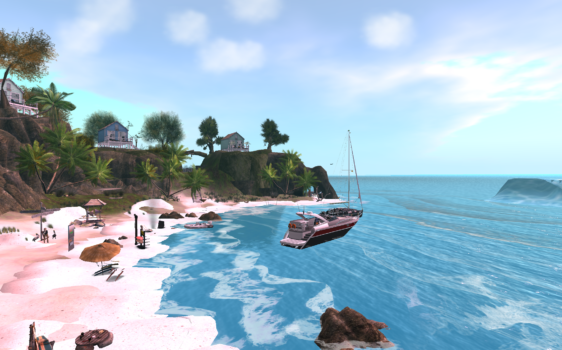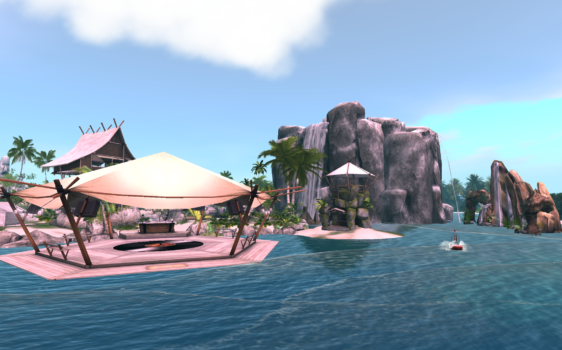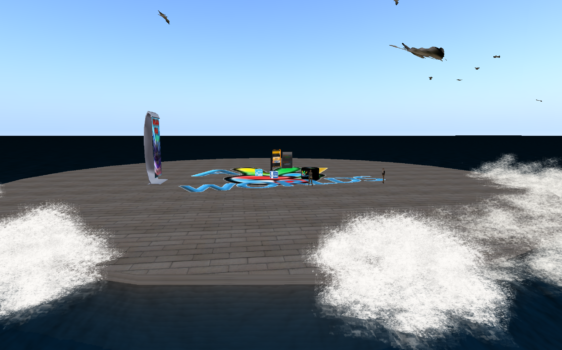
AviWorlds is celebrating a whole year of not closing down.

“To celebrate one year online AviWorlds is now offering $5 per month private regions with 25,000 prims,” grid owner Alexsandro Pomposelli told Hypergrid Business.
Pomposelli also says that he runs backups once an hour of all the regions, as well as of the grid database. There are also real-time backups of user inventories.
One year in business? Hasn’t AviWorlds been around longer?
It might seem strange for AviWorlds to be celebrating one year in business, since the grid was actually first founded in 2011. But regular readers of Hypergrid Business should be well aware by now that “not closing down” is a major accomplishment.
I care about business models. What makes a grid succeed? What attracts residents? How can grids thrive and help the OpenSim community grow?
As a result, when a grid closes down, or changes its business model, it’s something I pay attention to.
Whether it’s deliberate or not, AviWorlds has benefited from this, kind of. Each time the grid closes down amid scandal, public fights with employees, failure to refund digital currency, and massive loss of resident content, that makes the news.
And there’s been a lot of news about AviWorlds on these pages, more than about many of the more successful grids.
For example, the AviWorlds grid has officially shut down more than ten times over the course of its eight years of existence.
It’s changed hosting providers — Pomposelli has picked fights with all the major OpenSim hosting companies. At one point, it was an enclave on Kitely. At another, it was run out of his garage. There have been outages galore. Fights over copyrights. You name it. If there’s a problem that a grid could have, AviWorlds has had it, and has had it in full public view.
And the AviWorlds business model has changed repeatedly and dramatically. It’s gone from billing itself as the most expensive grid in OpenSim, trying to charge premium prices for not-so-premium content on the assertion that this somehow benefits the in-world land market, to giving a hundred regions away for free. Neither of these approaches proved sustainable, for obvious reasons. Yet Pomposelli has repeatedly swung from this one extreme to another, each time saying that this time would be different. Spoiler alert: It wasn’t.

Somehow, people kept coming. Back when it was hosted with reliable providers, I got confirmation that the traffic to the grid was, in fact, real traffic. For some reason, the grid is popular with Brazilians in particular. In 2016, the grid was regularly reporting more than 2,000 unique visitors a month — an extremely high number for OpenSim, putting in on our more popular grid lists.
As a couple of larger Brazilian grids have shut down recently, AviWorlds, in theory, stands to benefit.
This past August, the grid reported more than 600 unique monthly visitors. A steep drop from its heyday, but still a very decent showing.
This month, though, it only reported 177 active users.
I visited the grid today to check it out, as well as its website and Facebook page.
What’s going on? And where is it happening?
The first and most obvious issue I have with the grid is that there’s no information anywhere on what to do.
My top recommendation for all grid owners is to make sure events are prominently featured on grid websites, in social media feeds, and in welcome areas. People come to virtual worlds to do things with other people. They might come once to look at a pretty region, or to get some freebies, but they’ll come back again and again to hang out with other people.
AviWorld’s welcome area is a simple platform in the middle of an empty ocean.

There’s a sign asking people to sign up for grid announcements, a donation board, and a freebie teleporter from OpenSimWorld and a land sales ad. Nothing about the things people might want the most — what’s happening, where to go for the free homes, where to go shopping, where the hot destinations are.
I signed up for the grid announcements group. In the past two weeks, there have been exactly zero announcements related to events. A couple of announcements about stores, one about some grid downtime, and an announcement that hypergrid connectivity was enabled again. That’s it.
The website is similarly bare. It’s got the basics, but, again, nothing that would actually make people want to visit the grid. The Facebook page is similarly devoid of any signs of in-world events or people actually doing anything at all in-world. Just ads for the grid itself.
Is it because residents don’t trust the official communication channels? After all, the grid does delete its social media accounts on a regular basis for no apparent reason. The current Facebook page only goes back to June, and nearly all the posts are just ads for the grid. The Facebook Group I have bookmarked that was active earlier this year has been shut down.
If the residents go elsewhere to chat about what they’re doing in-world, where do they go? Are there unofficial resident groups somewhere? If anyone knows, please share!
I asked Pomposelli — several times — where people can go to find out what’s happening on the grid. He ducked the question.
“I don’t organize parties,” he said. “I leave that to the residents.”
Okay, so do lots of other grids — but they still have official grid calendars or social media feeds packed full with live music, dances, classes, and lots of other things to do.
Picking the wrong battles
Invariably, Pomposelli focuses his energies on the irrelevant. Right now, for example, his biggest beef is with the fact that Outworldz owner Fred Beckhusen offers DreamGrid, a free, easy-to-use OpenSim installer that people can use to run regions and even entire grids on their own computers.
“Fred’s installer is a major burden to all of us,” said Pomposelli. “More and more people are using it. That’s the reason I am reorganizing everything.”
Of course, there have been free installers of OpenSim since day one. In fact, OpenSim itself is free, open source software. That’s what it’s supposed to do! And while core OpenSim may be tricky to configure, there have always been easy-to-use versions, such as the Diva Distro and the now-defunct New World Studio. OSgrid makes it very easy for people to run individual regions at home that they can attach to OSgrid with their own custom installer.
If someone wants to run their own OpenSim land they’ve always been able to do it for free, at home, on their own computers.
And many folks do, especially those that are at all technically inclined.
I’ve done it. Repeatedly. But then I have to deal with the fact that I have to take care of my own backups. That I have to worry about having a good enough Internet connection, and that my routers are configured properly to manage traffic. That I have to keep up with updates. And that in order for people to be able to visit my region, my computer has to be running all the time. That’s a pain in the butt. It’s much easier for me to spend a few bucks and have someone else do it all for me.
Considering that a region in Second Life costs more than $200 a month — compared to an average of $15 in OpenSim with more land and more prims — even commercially-hosted OpenSim is a steal.
And land isn’t even the only way that grids can monetize their platform.
It isn’t being done enough, in my opinion, but grid owners would do well to look at other successful gaming platforms. Many extremely successful commercial games have free basic subscription tiers, and make money from premium add-ons. In order for that to become possible with OpenSim, the average cost of providing regions would have to drop significantly.
Beckhusen is actually working on this, with an on-demand feature in DreamGrid that would put regions to sleep when they’re empty. That would allow commercial grid operators using DreamGrid to offer regions at lower prices, or even for free, as loss leaders.
OpenSim could also become a lot more scalable. Right now, it’s hard to get more than a few dozen avatars into a single region. There have been experiments with support for larger groups, or sharding — creating multiple copies of busy regions — but they haven’t been turned into practical tools that grid owners can use.
Finally, there’s the viewer usability problem. More and more games are moving to web browsers or mobile apps, while OpenSim has neither. Plus, the navigation is non-standard and tricky to learn for first-time users.
OpenSim grid owners can also look closer to home. The biggest source of new users for OpenSim grids isn’t trying to steal them from other grids, or from home-based free distributions.
The best place is Second Life, where the users are used to the interface and might be getting tired of the high prices. Pomposelli would be better served to make it easier for people in Second Life to learn about his grid, to configure their viewers so they can access it, and help them get started on AviWorlds by helping them find communities and make friends.
- Analysts predict drop in headset sales this year - March 25, 2025
- OSgrid enters immediate long-term maintenance - March 5, 2025
- OSgrid wiping its database on March 21: You have five weeks to save your stuff - February 15, 2025
